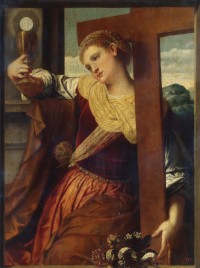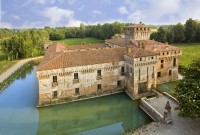The Tutela Patrimonio Culturale unit of the Carabinieri, a division of Italy’s national police squad dedicated to investigating stolen art and antiquities, has found a 16th century painting by Alessandro Bonvicino, better known as Moretto da Brescia, that disappeared from a church 60 years ago. It was discovered in Brescia, in the home of a businessman who had owned it for years without knowing its shady history.
 Faith, one of six known paintings Moretto made depicting the allegorical figure of Faith holding the Holy Chalice, was removed from the small parish church of Santa Maria in Valverde in the community of Padernello near Brescia in 1944. It was an inside job: the thief was the parish priest, don Staurenghi. He had noble (by his standards) motives for running what proved to be a very effective, long-lasting scam. The church needed money to build an oratory, so he took it upon himself to secure funding by selling the church’s Renaissance gem to an old friend from his hometown of Verolanuova who happened to be the town magistrate.
Faith, one of six known paintings Moretto made depicting the allegorical figure of Faith holding the Holy Chalice, was removed from the small parish church of Santa Maria in Valverde in the community of Padernello near Brescia in 1944. It was an inside job: the thief was the parish priest, don Staurenghi. He had noble (by his standards) motives for running what proved to be a very effective, long-lasting scam. The church needed money to build an oratory, so he took it upon himself to secure funding by selling the church’s Renaissance gem to an old friend from his hometown of Verolanuova who happened to be the town magistrate.
To ensure their backdoor shenanigans weren’t found out, the magistrate hired painter and restorer Giambattista Bertelli (who not coincidentally was also from Verolanuova) to make a copy of the painting to hang in the church. He made no bones about the nature of the gig. Bertelli was explicitly told that he had to do a really good job because his work was going to be passed off as Moretto’s in the parish church and it was imperative that nobody notice the switcheroo. From October 19th until October 28th of 1944, Bertelli had the original in his studio (he would decades later note that it’s much easier to forge a painting when you have the original in your workspace) while he painted the copy on a 500-year-old canvas he’d sourced specifically for the job in Milan.
His copy of course included a later modification of Moretto’s design overpainting the Host with the three nails of the crucifixion. That iconographic alteration was the distinguishing feature of the Padernello version. While the apocryphal Faith deceived the faithful in church, in 1969 the original was restored to Moretto’s original image of the Eucharist. I’ll give you one guess who the restorer was. If you guessed Giambattista Bertelli, congratulations. Truly you have a dizzying intellect. Or you just figured out that to run a con without a false step for decades, you’ve got to dance with them that brung you. Over time the copy disappeared too and the fact that the church had ever had one of Moretto’s Faith paintings faded from memory.
 The first clue to unlock the mystery was found in 1998, 54 years after the theft, in the Castle of Padernello. A group of volunteers dedicated to the conservation of the castle were cleaning up a pile of trash in an area that had been inhabited by the family of the Counts Salvadego until the 60s when they came across a “santino” (a card with holy imagery, often of a saint, that was traditionally printed to hand out on the more important days of the liturgical calendar) bearing a picture of Faith. It was labelled “Faith, parish of Padernello.” This was evidence that one of the six Moretto Faith paintings had once hung in the parish church.
The first clue to unlock the mystery was found in 1998, 54 years after the theft, in the Castle of Padernello. A group of volunteers dedicated to the conservation of the castle were cleaning up a pile of trash in an area that had been inhabited by the family of the Counts Salvadego until the 60s when they came across a “santino” (a card with holy imagery, often of a saint, that was traditionally printed to hand out on the more important days of the liturgical calendar) bearing a picture of Faith. It was labelled “Faith, parish of Padernello.” This was evidence that one of the six Moretto Faith paintings had once hung in the parish church.
Historian Gian Mario Andrico set to researching the whereabouts of the original. He found that the santino card had been printed by don Staurenghi for Easter of 1945, months after the copy was in place with no one the wiser (I’m rather in awe of his shamelessness). A few of the old timers remembered that the painting had once hung in the chapel with the baptismal font. Then Andrico tracked down Giambattista Bertelli. Proud of his meticulously maintained records documenting his involvement in this fraud (and since I’d wager his co-conspirators were dead and buried by then), Bertelli cheerfully spilled the beans.
In 2008, the Castle hosted an exhibition entitled Moretto, Faith, The Return that told the story of the purloined painting and displayed another version of it from a private collection. The Carabinieri used the catalogue from this exhibition as the starting point for an official investigation this year. It only took them a few months to locate the long-lost work along with a black-and-white photograph of it from the late 1960s. The magistrate had sold it to an antiques dealer who in turn sold it to the businessman in Brescia.
The art squad searched the church and found an altarpiece painting on the theme of the Sacred Heart that when viewed against the light showed anomalous elements. To ensure they had located the Padernello Faith instead of another version by the master or a copy, the police took the sequestered Faith, the black-and-white photograph and the altarpiece an to the laboratory of the Physics department of the State University of Milan for analysis. Infrared reflectography confirmed that the photograph was of the painting found in the apartment with it and that it was Moretto’s original. X-ray imaging found that the altarpiece had painted over a large cross that matched the one held by the allegorical Faith. Thus the fate of Bertelli’s copy was revealed.
The Carabinieri transferred legal custody of Faith to a representative of the parish but it’s not hanging in the church. Right now it’s in the Diocesan Museum of Brescia. I suspect this will be the long-term home for it, even though the church officially owns it again at long last.
Fascinating story… And NOT the first and only time in Italy’s long and glorious history that such a thing happened.
Butthe most remarkable aspect is the timing – late 1944. Italy had basically collapsed and nearby Milan(where Bertelli sourced his 16th century canvas) was a heap of ruins. (We all know the photographs of Leonardo’s Last Supper covered with tarps on the one remaining wall of the refectory of Santa Maria delle Grazie.)
Meanwhile, in nearer-by Brescia,the ruins were still smoking, after the aerial bombardment on 13 July 1944. Rescuing and securing what remained was the order of the day.
And meanwhile, a small-town priest is playing the old game of switcheroo, because – say what?! – his church needed money to build a new oratory. Are we talking “noble” here or are we talking “delusional”???
It is something of a classic tale, isn’t it? The hometown conspirators, the under-the-table deal between priest and magistrate, the decades of silence from all parties, even the painting remaining so close to home instead of making its way into one of numerous Swiss private collections.
I couldn’t tell from the articles if the oratory was totally new or if it was a rebuild after war damage. It seems like a huge coincidence that he’d be looking to build new in 1944 when all around him were smoking piles of ruins.
It was very amazing story. i read this and enjoy .. ya its was very historical. nice post . thanks for sharing.